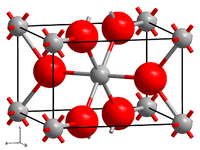Iridium (IV) oxide
| Crystal structure | |||||||||||||||||||
|---|---|---|---|---|---|---|---|---|---|---|---|---|---|---|---|---|---|---|---|

|
|||||||||||||||||||
| __ Ir 4+ __ O 2− | |||||||||||||||||||
| General | |||||||||||||||||||
| Surname | Iridium (IV) oxide | ||||||||||||||||||
| other names |
Iridium dioxide |
||||||||||||||||||
| Ratio formula | IrO 2 | ||||||||||||||||||
| Brief description |
|
||||||||||||||||||
| External identifiers / databases | |||||||||||||||||||
|
|||||||||||||||||||
| properties | |||||||||||||||||||
| Molar mass | |||||||||||||||||||
| Physical state |
firmly |
||||||||||||||||||
| density |
11.7 g cm −3 |
||||||||||||||||||
| Melting point |
changes to iridium trioxide at 1200 ° C |
||||||||||||||||||
| solubility |
almost insoluble in water |
||||||||||||||||||
| safety instructions | |||||||||||||||||||
|
|||||||||||||||||||
| As far as possible and customary, SI units are used. Unless otherwise noted, the data given apply to standard conditions . | |||||||||||||||||||
Iridium (IV) oxide or iridium dioxide is a chemical compound and an oxide of iridium that changes to iridium trioxide at 1200 ° C. The pure substance is a black solid, the hydrate a blue-black solid.
Extraction and presentation
Iridium dioxide is produced when iridium is burned. Since iridium is extremely inert, high temperatures and pure oxygen are necessary.
It can also be obtained by oxidizing iridium (III) chloride with oxygen at 600 ° C.
Single crystals of the oxide can be produced using a CVT (Chemical Vapor Transport) method . For this purpose, iridium sponge is first converted into polycrystalline oxide in a stream of oxygen at 1000 ° C. This oxide is then converted into a volatile oxide in a 3-zone furnace in a stream of oxygen at 1190 ° C., which then decomposes again into oxygen and iridium (IV) oxide in a colder region of the tube at 1090 ° C., with millimeter-sized Single crystals of the target compound arise. A reaction time of about 15 days is required for the conversion of 2 g of the polycrystalline starting material.
properties
Physical Properties
Iridium (IV) oxide crystallizes in the tetragonal crystal system with the space group P 4 2 / mnm (space group no. 136) and the lattice parameters a = 449.83 pm and c = 354.4 pm, in the unit cell there are two formula units . The structure thus corresponds to the rutile structure.
Chemical properties
When iridium or iridium dioxide is heated to 1200 ° C, iridium trioxide is formed in the presence of oxygen, but it is only stable in the gas phase and cannot be obtained as a solid.
use
Iridium dioxide is used to coat electrochromic materials or metallic electrodes in medical technology to improve corrosion properties and biological compatibility.
Individual evidence
- ↑ a b c d data sheet iridium (IV) oxide from AlfaAesar, accessed on December 14, 2012 ( PDF )(JavaScript required) . .
- ^ A b c A. F. Holleman , E. Wiberg , N. Wiberg : Textbook of Inorganic Chemistry . 102nd edition. Walter de Gruyter, Berlin 2007, ISBN 978-3-11-017770-1 , p. 1702.
- ↑ Data Sheet Iridium (IV) oxide from Acros, accessed on 23 February 2010 .
- ↑ Georg Brauer (ed.) U. a .: Handbook of Preparative Inorganic Chemistry. 3rd, revised edition. Volume III, Ferdinand Enke, Stuttgart 1981, ISBN 3-432-87823-0 , p. 1734.
- ↑ DB Rogers et al .: Single crystals of transition-metal dioxides - A. Ruthenium and iridium dioxides . In: FA Cotton (Ed.): Inorganic Syntheses . tape 13 . McGraw-Hill Book Company, Inc., 1972, ISBN 978-0-470-13244-9 , pp. 135-145 (English).
- ^ Jean D'Ans, Ellen Lax: Pocket book for chemists and physicists. 3. Elements, inorganic compounds and materials, minerals, Volume 3. 4. Edition, Springer, 1997, ISBN 978-3-5406-0035-0 , p. 496 ( limited preview in the Google book search).



